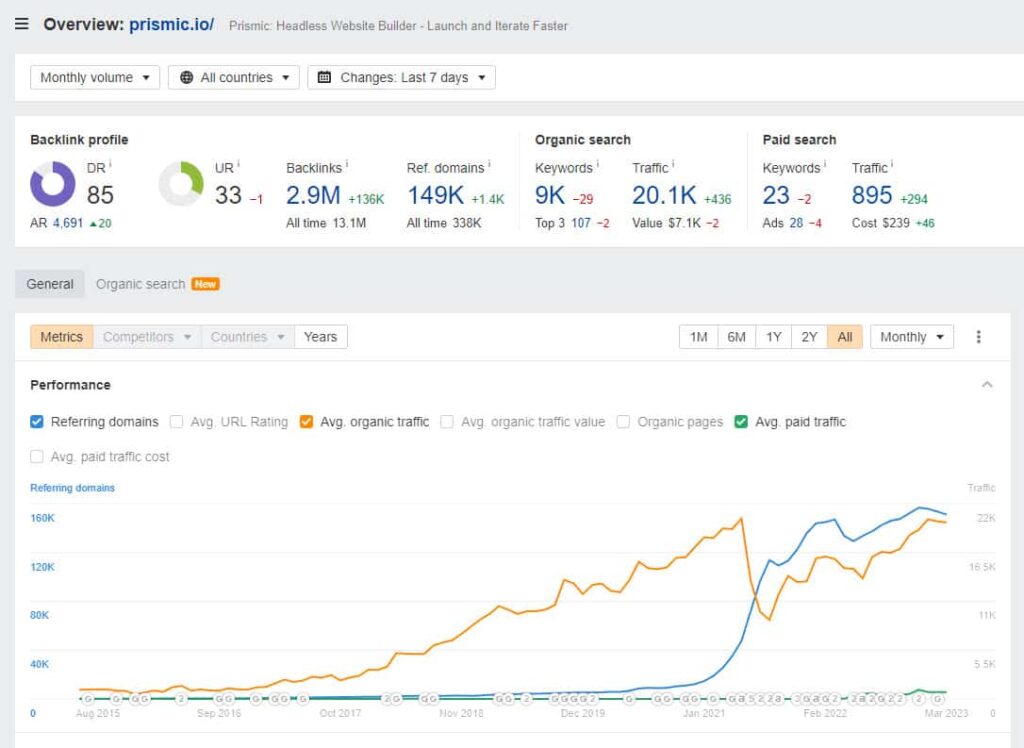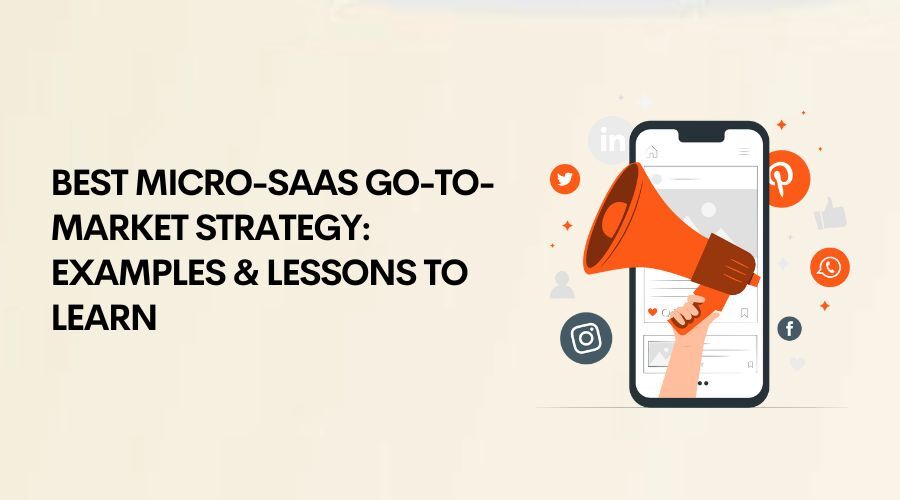Are you looking for a micro-SaaS go-to-market strategy example?
You’ve come to the right place.
All companies need a strong marketing strategy to reach their target market, but this is especially true for those that are still about to launch their micro-SaaS products.
In today’s post, we’ll help you find and develop the right go-to-market strategy for your software business.
Let’s dive in.
What Is a Micro-SaaS Go-to-Market Strategy?

The go-to-market strategy refers to a business’ action plan towards getting your software product in front of your potential customers so as to generate revenue.
This is a vital part of your micro-SaaS marketing success, as it lets you save valuable time and resources while keeping potential customers.
After all, go-to-market strategies…
- Clearly define the direction for the team members involved,
- Increase your chances of successful product launches, and
- Ensure you can respond to changes in what customers want within a reasonable time.
The good news is that there are several go-to-market strategies you can use to grow your micro-SaaS.
Each strategy has its strengths and weaknesses, and it’s up to you to decide which approach best suits your product and audience.
Top 4 Go-to-Market Strategies
1. Product-Led GTM
Product-led go-to-market strategies focus mostly on the product experience.
This means that instead of relying on traditional marketing and sales tactics, the product becomes the main driver of growth.
It’s a popular strategy in the micro-SaaS world because it aligns with how customers in today’s digital age want to try a product before buying it.
By offering a free trial or freemium model, companies can let their product do the selling for them.
Many micro-SaaS use the freemium model to grow their customer base, but one example that does it really well is Storemapper.

This tool uses a freemium model allowing business owners to embed a map of their brick-and-mortar stores on their websites so that their customers can easily find and buy their products and services.
This has led to explosive growth for the company, which has since been the subject of acquisition by SureSwift Capital.
When done correctly, as Storemapper did, product-led go-to-market strategy can reduce customer acquisition costs because of how effective the product is.
Instead of constantly reaching out to your audience, word-of-mouth will be so strong that people will seek out your product instead.
And when people stick around as customers since your product is that good, it also leads to higher customer lifetime value (LTV).
To compute for LTV, multiply the customer value (i.e., average purchase value multiplied by the purchase frequency) with the lifespan.
Here’s an example.
Let’s say the monthly estimated value of each sale is $50.
If each user buys twice a month, your customer value is $100 in a month (50 x 2).
If your customers have an average lifespan of three years, your customer lifetime value is $300 (100 x 3).
The goal is to have a higher LTV than the amount you spend acquiring customers.
If you spend more than $300 to attract new micro-SaaS customers, you must rethink your strategy by finding ways to grow your revenue.
Below are tips to increase your LTV under a product-led growth model:
1. Increase average order value
Customers don’t mind paying for products as long as they can use the items to improve their lives.
In this case, cross-sell and upsell related micro-SaaS products to their initial orders and bundle them at a much lower price.
Grouping the orders allows you to get more value from each order your customers make.
2. Refine your onboarding strategy
Upon signing up, customers may need to learn how to use your software to its full potential.
Thus, it’s your job to inform them by showing tooltips whenever they hover over your product features.
Also, add contextual tips and hints that teach users the step-by-step process of using all the features.
3. Improve customer relations
Provide omnichannel support so customers can choose the best way to contact your team.
Also, reply as soon as you can to their messages. This shows them that they matter and their success in using your product is just as crucial to your brand.
2. Community-Led GTM

Community-led go-to-market strategy is one that aims to build a vibrant community of users who are loyal to your micro-SaaS product.
Doing so enables you to build stronger customer relationships, resulting in higher retention rates and growth through word-of-mouth.
Not only that, but turning your users into your best advocates also gives you valuable customer feedback to improve your micro-SaaS and make it more user-friendly.
In essence, it can help you not only retain customers but also attract new ones.
An excellent example of a community-led growth strategy for micro-SaaS companies is Group Leads.
Although this micro-SaaS software has a great following for making Facebook group funnels, its vibrant community is what took it to a whole new level.
Its group serves as an avenue for users to provide constructive product feedback and how to make it better.
So, clearly, Group Leads won’t be the same without its community of active users.
Metrics to Measure Community-Led Growth
In the case of community-led growth, non-customers asking questions about your micro-SaaS product makes them eligible as product-qualified leads (PQLs).
In case you didn’t know, PQLs are leads that perform actions within your micro-SaaS product with the highest purchase intent.
Still, their eligibility as PQLs also depends on their question.
For instance, questions about why they should subscribe to your micro-SaaS bear more weight compared to those inquiring about what features your software has.
From here, you can personally contact them to schedule a product demo.
Or, even better, let other community members answer their questions for you.
For brands just starting with their community-led go-to-market strategies, below are basic metrics you can measure first:
- Number of community members
- Number of new members over time
- Number (and quality) of engagement in the community
- Number of new sign-ups coming from the community (referral traffic and conversions)
Monitoring these metrics enables you to understand how to improve your community further.
For instance, if you have more members leaving your community than joining, find out why.
Maybe your posts aren’t engaging enough, or your community management activities aren’t charming your members to the group.
Either way, these metrics provide insights into improving your community to benefit your micro-SaaS product.
3. Sales-Led GTM

Sales-led go-to-market strategy means a sales team takes charge in driving revenue for your micro-SaaS product by acquiring new customers.
This strategy works well for micro-SaaS companies with higher customer LTV and relies heavily on personal relationships to close deals.
The downside is that it can be expensive, especially in the early stages of a company’s growth.
After all, you need sales representatives to help build relationships with individual prospects.
Keeping them as part of your payroll can be expensive, but not if they’re converting their leads into customers.
That said, the closing rate is the main KPI to measure in your sales-led growth strategy.
To justify having a sales team in your micro-SaaS, they need to convert as many prospects into paying customers as possible.
Now, a low close rate doesn’t necessarily mean your sales team is doing a poor job closing leads.
There are lots of variables that can affect your close rate.
It’s only a matter of knowing which ones influence the success of your sales reps in turning people into paying customers.
Below are ways to help boost your sales-led growth initiatives:
1. Give your sales team highly qualified leads
Trying to convert people who aren’t ready to make a purchasing decision is only a waste of everyone’s time.
So, why not send leads instead that are most likely to become clients based on their previous behavior?
Get help from your marketing team to target who potential users are and ask them to coordinate with your sales team regarding their findings.
2. Analyze the sales team’s performance

One thing you have to know is that a 100% closing rate is almost impossible.
Nonetheless, the goal is always to maximize your conversion rates.
Let your sales manager monitor your representatives and give them helpful feedback.
Also, run demos with your reps so that you and the manager can determine what needs fixing before they join your sales campaigns.
3. Diversify communication channels
Don’t limit yourself to calls when converting leads. Instead, offer email, live chat, knowledge base, chatbots, SMS, and other means of communication that suit your customers.
It’s all about providing your potential customers with the best experience possible to ease them into becoming customers.
A SaaS business that does sales-led growth right is Salesforce.
It’s a customer relationship management (CRM) platform that helps users keep their customers happy by uniting their commerce, marketing, sales, and IT departments.
You can attribute its success to its dedicated sales team, whom people can ask about their different products and pricing policies.

By having chat boxes on its site pages, Salesforce can funnel all inquiries here and monitor how the conversations of their sales representatives are going with customers.
4. Marketing-Led GTM

Marketing-led go-to-market strategy brings brand awareness and lead generation through marketing channels.
This strategy is effective for micro-SaaS companies looking to acquire a high volume of customers to drive growth.
There are many ways micro-SaaS can promote their product to their target audience. Below are the more popular channels:
1. Content marketing
Create and distribute content on platforms that most of your target audience uses to increase visibility.
2. Social media marketing
Engage with your audience on Facebook, Twitter, Instagram, and more by building a massive following with your content.
3. Email marketing
Get subscribers to sign up for your email list and send relevant content to their inboxes.
The emails should delight subscribers or convert them into customers.
4. Paid advertising
Show your business ads directly from your target audience’s social feeds or on top of search results for the keywords you bid.
This method provides the fastest way to reach prospects and engage them into becoming customers.
Take note, though, that you must have a budget when launching an ad campaign to bid for the right keywords or target the correct demographics.
5. SEO
Rank relevant pages of your website on Google Search to maximize click-through and conversion rates.
This method takes months or even years to see your SEO campaigns’ effects.
But once the results kick into full gear, you can enjoy hundreds and thousands of highly targeted traffic without constantly launching campaigns.
Take Prismic, for example.
A headless website builder, its primary traffic source is organic search.
Its content strategy, which includes blog posts and documentation, ranks at the top of Google search for its target keywords.
According to Ahrefs, it’s currently generating 20.1k organic monthly traffic.

The graph shows that the site didn’t get much traffic until 2018.
So, while SEO takes time, it eventually manifests with great traffic, especially when done correctly.
Also, it’s interesting to point out that Prismic dropped traffic around August 2021.
However, it still recovered its traffic thanks to the growing backlinks it built.
Aside from content creation, link building is a crucial SEO component that helps round out your online authority.
The better your content and links are, the higher your organic traffic will become.
Of course, traffic volume is useless if it doesn’t produce more customers for your micro-SaaS.
Therefore, when conducting marketing-led growth, it’s vital that you ensure visitors perform your desired action when visiting your website.
The key here is utilizing different marketing-led growth strategies to fill your sales funnel.
For example, just because SEO and paid advertising are different doesn’t mean you can’t use them together in your campaign.
In this case, you can run paid ads campaigns to generate customers in the short term and simultaneously prepare an SEO strategy for your long-term growth.
To optimize your content, you should target terms with informational content to engage people in the awareness stage of your funnel.
Then create landing pages optimized for commercial keywords for your funnel’s decision stage.
This way, more people interested in buying your product can make their purchase there.
Final Thoughts on Go-to-Market Strategies for Micro-SaaS
The best micro-SaaS go-to-market strategy will be different for everyone.
But with careful planning and research using the information above, you can choose the best strategy that will help grow your micro-SaaS business.
Now, if you need help developing and implementing a GTM strategy for your micro-SaaS product, we at Symalite Labs can help.
As a startup studio, we successfully work with micro-SaaS founders to achieve their software goals.
Click here to learn more about how we can help you.

